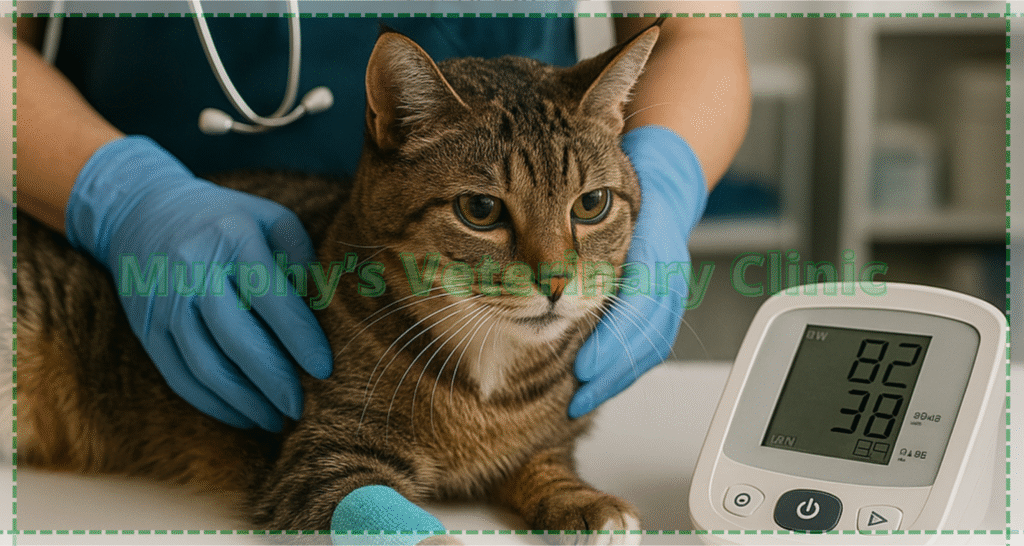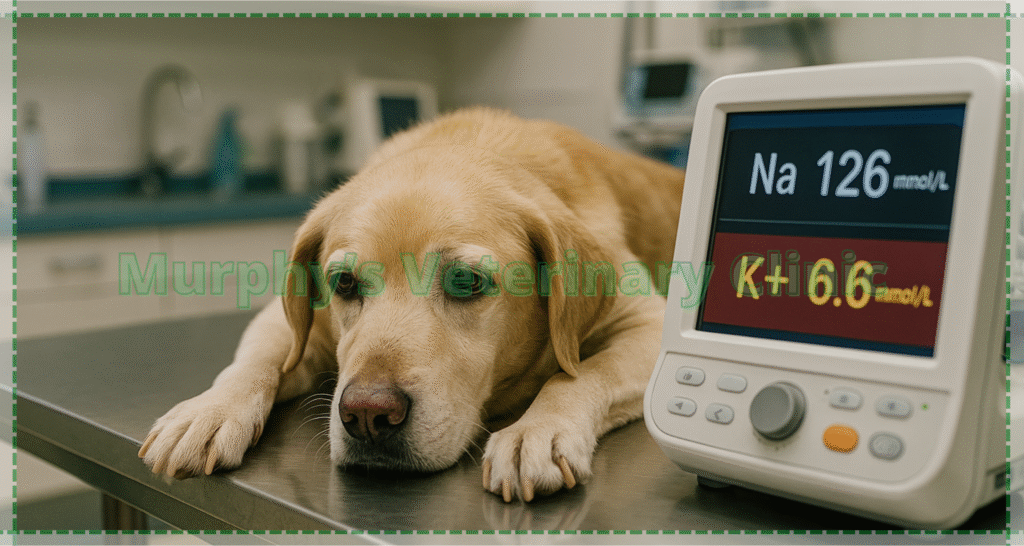Diseases & Treatments, Emergency & First Aid, Health & General Care, Special Care
Addison’s Disease in Pets
Topics covered in this article:
- Loss of Appetite and Weight in Addison’s Disease in Pets
- Weakness and Lethargy in Pets with Addison’s Disease
- Frequent Vomiting and Diarrhea in Addison
- Severe Blood Pressure Fluctuations in Addison’s Disease
- Electrolyte Imbalance in Addison
- Conclusion
Addison’s disease in pets is a rare but serious disorder affecting adrenal gland function, leading to insufficient production of essential hormones like cortisol and aldosterone. This disease is often mistaken for minor digestive or behavioral issues, causing delays in diagnosis. Since its symptoms may appear mild or scattered, early detection is challenging. In many cases, pets progress to an Addisonian crisis, a state of shock that can be fatal if not treated promptly. Managing Addison’s disease in pets requires lifelong hormone replacement and ongoing medical monitoring. Pet owners must be aware of the warning signs to act swiftly at the first indication of illness. The goal of this article is to provide a comprehensive overview of symptoms, causes, diagnostic methods, and treatment options for this condition. It also emphasizes the vital role of professional veterinary clinics in effectively managing Addison’s disease in pets. Let’s take a closer look at how to protect our beloved animals from this life-threatening issue.
| Ultrasound plays a valuable role in the diagnostic process for Addison’s disease in pets, especially when initial symptoms are vague or resemble other conditions. Through abdominal ultrasound, veterinarians can evaluate the size and appearance of the adrenal glands. In many cases of Addison’s, the glands appear smaller than normal, which serves as a critical clue. This non-invasive imaging method also helps rule out other possible causes of vomiting, lethargy, or weight loss. When combined with blood tests and clinical signs, ultrasound improves diagnostic accuracy. Early and precise detection through ultrasound can lead to quicker treatment and a better prognosis for pets suffering from Addison’s disease in pets. |

Loss of Appetite and Weight in Addison’s Disease in Pets
One of the earliest and most common symptoms of Addison’s disease in pets is severe disinterest in food and rapid weight loss. A pet that previously ate with enthusiasm suddenly refuses food. This behavior is caused by hormonal imbalance and the body’s inability to regulate normal metabolism. Without treatment, weight loss can become significant and dangerous. In some cases, the pet may also refuse to drink water, leading to dehydration and worsening health. These symptoms are sometimes confused with dental pain or depression. If unexplained weight loss continues, it is crucial to test for Addison’s disease in pets.
- Severe disinterest in food: Pets may sniff food but avoid eating.
- Gradual or sudden weight loss: A clear drop in body mass despite a consistent diet.
- Chronic nausea: Ongoing nausea causes aversion to eating.
- Avoiding food bowl: Pets may physically back away from their food.
- Visible thinning: Most noticeable in the spine, hips, and ribs.

Weakness and Lethargy in Pets with Addison’s Disease
Pets with this condition are often lethargic, weak, and unmotivated. They avoid normal activities and spend most of their time lying down. This weakness stems from cortisol deficiency, which plays a key role in energy regulation. Pets may struggle to stand or may suddenly sit down during walks. Many tire quickly during play. These symptoms should be taken seriously, as they are early red flags for Addison’s disease in pets.
- Excessive sleeping: Pets sleep much longer than usual.
- Inability to stay standing: Muscle weakness makes standing difficult.
- Lack of response to stimuli: Pets show little interest in noise or movement.
- Hiding behavior: Some animals retreat to dark, hidden spots.
- No interest in toys or play: Even favorite toys are ignored.

Frequent Vomiting and Diarrhea in Addison
Digestive problems are prominent symptoms of Addison’s disease in pets. Adrenal hormones play a major role in regulating electrolytes, and when these are imbalanced, persistent vomiting, diarrhea, and nausea follow. The pet may suffer from digestive discomfort after every meal. This leads to dehydration and loss of vital electrolytes like sodium and potassium, further deteriorating health.
- Vomiting after meals: Often occurs shortly after eating.
- Recurrent diarrhea: Loose stools appear multiple times a day.
- Nausea even on empty stomach: The pet may gag or dry-heave.
- Foul-smelling breath: Caused by underlying digestive issues.
- Reluctance to drink water: Dehydration worsens symptoms.

Severe Blood Pressure Fluctuations in Addison’s Disease
One of the life-threatening outcomes of Addison’s disease in pets is sudden blood pressure drops, sometimes leading to fainting or shock. These fluctuations worsen during stress or secondary illness and require emergency medical attention. Below is a table summarizing key indicators of low blood pressure in pets:
| Symptom | Description |
| Pale gums | Indicate reduced blood flow |
| Weak heartbeat | Poor circulation and low oxygen delivery |
| Loss of balance | Pets stumble or collapse easily |
| Extreme lethargy | Severe weakness and inability to move |
| Short blackouts | Temporary unconsciousness in severe cases |

Electrolyte Imbalance in Addison
In Addison’s disease in pets, sodium and potassium levels become drastically unbalanced, causing neurological, muscular, and digestive issues. Blood tests that show low sodium and high potassium are among the main diagnostic tools. The following table outlines the effects of electrolyte imbalance in pets:
| Electrolyte | Abnormal Level | Effects |
| Sodium | Low | Dehydration, low blood pressure |
| Potassium | High | Irregular heartbeat, muscle weakness |
| Chloride | Low | Digestive disturbances |
| Glucose | Low | Fatigue, dizziness |
| Bicarbonate | Decreased | Metabolic acidosis, weakness |
Conclusion
Addison’s disease in pets is a chronic yet manageable condition. With awareness of its early symptoms and prompt intervention, severe outcomes can often be avoided. Although rare, it poses significant risks if left undiagnosed. Pet owners should closely monitor physical, behavioral, and digestive changes in their pets and consult a veterinarian at the first sign of concern. Maintaining a hormone replacement plan, balanced nutrition, and regular follow-up tests can ensure a better quality of life and longer lifespan. Early detection remains the key to successful treatment. Moreover, emotional support and a calm environment are essential to the recovery and stability of pets with Addison’s disease.
Murphy’s Veterinary Clinic, with its modern equipment and skilled veterinary team, is well-equipped to diagnose and manage Addison’s disease in pets. The clinic provides specialized blood tests, electrolyte monitoring, hormone replacement therapy, and ongoing care plans. In addition, nutritional guidance and behavioral consultations are offered to support the overall well-being of your pet. If you’re concerned about your pet’s health, Murphy’s Clinic is your trusted partner in care.


